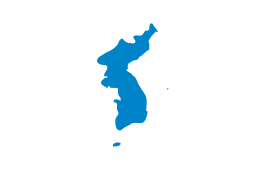Provisional Government of the Republic of Korea
The Korean Provisional Government (KPG), formally the Provisional Government of the Republic of Korea, was a partially recognized Korean government-in-exile based in Shanghai, China, and later in Chungking, during the Japanese colonial rule of Korea.
Provisional Government of the Republic of Korea 대한민국 임시정부 / 大韓民國 臨時政府 Daehanminguk Imsijeongbu | |||||||||||
|---|---|---|---|---|---|---|---|---|---|---|---|
| 1919–1945 | |||||||||||
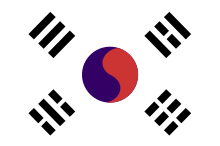 Flag
| |||||||||||
Seal of the Provisional Government  | |||||||||||
.svg.png) Map of the Korean Peninsula showing the government's territorial claims; controlled and occupied by Japan. | |||||||||||
| Status | Government in exile | ||||||||||
| Capital | Hanseong 1945–1948 (de jure) | ||||||||||
| Capital-in-exile | Shanghai 1919–1932 Hangzhou 1932–1935 Jiaxing 1935 Nanjing 1935–1937 Changsha 1937–1938 Guangzhou 1936–1939 Qijiang 1939–1940 Chungking 1940–1945 | ||||||||||
| Common languages | Korean | ||||||||||
| Government | Presidential (1919–1925) Parliamentary (1925–1940) Presidential (1940–1948) (All 3 Formed a Provisional Government) | ||||||||||
| President | |||||||||||
• 1919–1925 1947–1948 | Syngman Rhee | ||||||||||
• 1925–1925 | Park Eunsik | ||||||||||
• 1925–1926 | Yi Sang-ryong | ||||||||||
• 1935–1940 | Yi Dongnyeong | ||||||||||
• 1926–1927 1940–1947 | Kim Gu | ||||||||||
| Prime Minister | |||||||||||
• 1919–1921 | Yi Donghwi | ||||||||||
• 1924–1925 | Park Eunsik | ||||||||||
• 1944–1945 | Kim Kyu-sik | ||||||||||
| Legislature | Provisional Assembly | ||||||||||
| History | |||||||||||
| 1 March 1919 1919 | |||||||||||
• Constitution adopted | 17 March 1919 (Vladivostok) 11 April 1919 (Shanghai) 23 April 1919 (Seoul) | ||||||||||
• Government Unified | 11 September 1919 | ||||||||||
| 6 June 1920 | |||||||||||
• Battle of Chingshanli | 21 October 1920 | ||||||||||
• Hongkou Park Incident | 29 April 1932 | ||||||||||
• Declaration of War against the Axis powers | 9 December 1941 | ||||||||||
| 27 November 1943 | |||||||||||
| 17 July 1945 | |||||||||||
| 15 August 1945 | |||||||||||
• United States Army Military Government in South Korean Peninsula | 8 September 1945 | ||||||||||
• Soviet Civil Administration in North Korean Peninsula | 3 October 1945 1945 | ||||||||||
| Currency | Won | ||||||||||
| ISO 3166 code | KR | ||||||||||
| |||||||||||
| Today part of | China (exile) North Korea South Korea | ||||||||||
| Provisional Government of the Republic of Korea | |
| Hangul | |
|---|---|
| Hanja | |
| Revised Romanization | Daehanmin(-)guk Imsijeongbu |
| McCune–Reischauer | Taehanmin'guk Imsijŏngbu |
Part of a series on the |
||||||||
|---|---|---|---|---|---|---|---|---|
| History of Korea | ||||||||
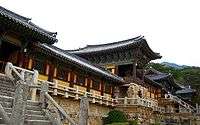 | ||||||||
| Prehistoric period | ||||||||
| Ancient period | ||||||||
|
||||||||
| Proto–Three Kingdoms period | ||||||||
| Three Kingdoms period | ||||||||
|
||||||||
| Northern and Southern States period | ||||||||
|
||||||||
| Later Three Kingdoms period | ||||||||
|
||||||||
| Dynastic period | ||||||||
|
||||||||
| Colonial period | ||||||||
|
||||||||
| Modern period | ||||||||
|
||||||||
| Topics | ||||||||
| Timeline | ||||||||
On April 11, 1919, a provisional constitution providing for a democratic republic named the "Republic of Korea" was enacted. It introduced a presidential system and three branches (legislative, administrative and judicial) of government. The KPG inherited the territory of the former Korean Empire. The Korean resisters actively supported and supported the independence movement under the provisional government, and received economic and military support from the Kuomintang of China, the Soviet Union and France.[2][3][4][5][6]
After the surrender of Japan on August 15, 1945, figures such as Kim Gu returned. On August 15, 1948, the Provisional Government of the Republic of Korea was dissolved. Syngman Rhee, who was the first president of the Provisional Government of the Republic of Korea, became the first President of the Republic of Korea in 1948. The current South Korean government claims through the 1987-amended constitution of South Korea that there is continuity between the KPG and the current South Korean state, though this has been criticized by some historians as constituting revisionism.
The sites of the Provisional Government in Shanghai and Chongqing (Chungking) have been preserved as museums.
Background
The government was formed on April 11, 1919, shortly after the March 1st movement of the same year during the Imperial Japanese colonial rule of the Korean peninsula.[7][8][9]
The Key members in its establishment included An Changho and Syngman Rhee, both of whom were leaders of the Korean National Association at that time. Changho played an important part in making Shanghai the center of the liberation movement and in getting KPG operations underway. As acting premier, he helped reorganize the government from a parliamentary cabinet system to a presidential system.[10]
The government resisted the colonial rule of Korea that lasted from 1910 to 1945. They coordinated armed resistance against the Imperial Japanese Army during the 1920s and 1930s, including at the Battle of Chingshanli in October 1920, and the assault on Japanese military leadership in Shanghai's Hongkou Park in April 1932.
Military activities
The government resisted the colonial rule of Korea that lasted from 1910 to 1945. They coordinated armed resistance against the Imperial Japanese Army during the 1920s and 1930s, including at the Battle of Bongoh Town in June 1920 and the Battle of Chingshanli in October 1920. Also, they hugely struck a blow the Japanese military leadership in Shanghai's Hongkew Park[11], April 1932.
This struggle culminated in the formation of the Korean Volunteer Corps[12] in 1938 and the Korean Liberation Army in 1940, bringing together all Korean resistance groups in exile.[13]
World war II
The government duly declared war against the Axis powers, Japan and Germany, on December 9, 1941, and the Liberation Army took part in allied action in China and parts of Southeast Asia. These efforts received the guarantee of liberated the Korean Peninsula from China, USA and the UK in the Cairo Conference and reaffirmed from USSR, USA and the UK in the Potsdam Conference.[14][15][16][17][18]
During World War II, the Korean Liberation Army was preparing an assault against the Imperial Japanese forces in Korea in conjunction with the American Office of Strategic Services. The government's goal was achieved with the Japanese surrender on September 2, 1945. However, USSR quickly attacked the Japanese force for gained the North part of the Korean Peninsula and this decision made the USA used the Atomic bombings of Hiroshima and Nagasaki for gained the early surrender of the Japanese Empire and blocked the USSR attempted strongly influence of Korean Peninsula. On August 15, 1945, the Japanese empire was collapsed and the Korea finally gained the Korean Peninsula. This independence was reaffirmed in the Treaty of San Francisco.[19]
After the Liberation of Korea
After the end of the WWII, US and USSR stationed army forces in Korean Peninsula. USSR already gained the north part of Korean Peninsula in attacked the Japanese empire and they made the Soviet Civil Administration after the end of the WWII. Similary, the US made the United States Army Military Government in south part of Korean Peninsula after the end of the WWII.
The almost leading members of Korean Provisional Government disagreed the these system of trusteeship to Korean Peninsula. Mainly, Left side person was Centre-left politician Lyuh Woon-hyung[20][21] and Right side person was Centre-right politician Kim Kyu-sik. They had each different opinion but disagreed the system of trusteeship and made the movement of collaborate with left and right.[22]
However, the US president of Harry S. Truman declared the Truman Doctrine on March, 1947. This doctrine made the accelerated the Cold War and affected the Korean Peninsula.
Formation
The Provisional Government of the Republic of Korea was founded in 1919 as part of the March 1st Movement. On January 21, 1919, rumors that Emperor Gojong was poisoned by[23] the Japanese imperial family came to light. This culminated in a demonstration that took place at the Emperor's funeral on March 1. Among the 20 million Koreans present, 3.1 million people participated in the demonstration, about 2.20 million, 10% of the total population.[24][25][26][27][28][29][30] There were 7,500 deaths, 16,000 injured, and 46,000 arrested and detained. The protests, which began in March and continued until May, included 33 people who had signed the Declaration of Independence, but were in fact held by the Japanese police.
The independence movement's popularity grew quickly both locally and abroad. After the March 1, 1919, campaign, a plan was set up at home and abroad to continue expanding the independence movement. However, some were hesitant due to their obedience to the occupying powers. At that time, many independent activists were gathered in Shanghai. Those who set up independent temporary offices repeatedly discussed ways to find new breakthroughs in the independence movement. First, the theory of provisional government was developed, and it was generally argued that the government should organize a government in exile against the Chosun governor's office. However, it was argued that the party was not sufficiently equipped to form a government.
Shanghai was a transportation hub and also a center of support for the Guangdong government led by Wu Yuan. In addition, there were delegates from Britain, France, Germany, and the United States, which allowed them to escape the influence of Japan. For this reason, independent offices flocked to Shanghai.
Independence movements in Shanghai moved more aggressively in the summer of 1919. Seo Byeong-ho, Seung-hyung Cho, Dong-ho Cho, Park Chan-ik, and Sun Woo-hyuk met with the governments from Korea, Manchuria, the Russian Maritime Province and the Americas. Shanghai's independent offices provided accommodation for people from outside the country, centering on the French settlement, and organizing social gatherings for Koreans to create a close network. Around this time, the highly respected independent branch offices of Manchu and the Maritime provinces, such as Dongying, Lee, Shim, Kim DongSam, Shin Chae Ho, Cho Sung Hwan and Chaosang, came to Shanghai and were sent to Korea.
Paris Peace Conference
The Shinhan Youth Party[31] wanted a promise of independence in Korea at the 1919 Paris Peace Conference and dispatched Kim Kyu-sik as a delegate. Since his childhood, he had been studying at the Underwood Academy, where he received a Western education in English, Latin, theology, mathematics, and science. He was multilingual able to speak English, French, German, Russian, Mongolian and Sanskrit as well as Korean, Chinese and Japanese. He delivered the Korean Independence petition to President Woodrow Wilson in the name of the Shinhan Youth Party, and went to Paris, France, in January 1919 to submit a petition in the name of the Provisional Government of the Republic of Korea. However, he was not allowed to attend the Peace Conference because the provisional government had not yet been established. Kim subsequently formed a provisional government to receive the credentials of officially representing the Korean government. Kim's trip to the conference became the motivation for the March 1st Movement and the establishment of the Provisional Government of the Republic of Korea.

Before his departure, Kim ordered the Shinhan Youth Party members to hold an independent demonstration, saying: "Even if sent to Paris, Westerners do not know who I am. To expose and propagate Japanese rule, one must declare independence in Korea. The person to be dispatched will be sacrificed, but what happens in Korea will fulfill my mission well."[32][33][34]
Kim Kyu-sik communicated with the Shinhan Youth Party in Paris by radio, and they raised money for the lobbying effort. Inspired by Kim Kyu-sik's arguments, the Shinhan Young Youth Party sent people to Korea and met with national leaders such as Ham Tae-young and Cho Man-sik. Kim Kyu-sik's order for independence demonstrations was the moment when the March 1, 1919 campaign began.
Participants at the time of the establishment of the Provisional Government of the Republic of Korea were Kim Kyu-sik, representative of the Shinhan Youth Group, Lyuh Woon-Hyung, Kim Cheol, Sun Woo Hyuk, Han Jin Kyo, Chang Deok soo, Cho Dong Ho, Seo Byung Ho and Kim In Jon. There were 30 people including Nam Hyung Woo, Shin Ik-Hee, Yi Si-yeong, Yi Dong-nyeong, Cho Wan Gu, Sin Chaeho, Jo So-ang and Kim Dae Ji. In addition, Kim Gu, Yi Dong-nyeong participated in the establishment, and Ahn Changho, Yi Dong-hwi, and Syngman Rhee were appointed as the Emperor of Shanghai from April to September 1919 and entered Shanghai.
Korean Imperial Household attempt to join the KPG
Former empire personnel also participated in the establishment of the Provisional Government of the Republic of Korea. Kim Gajin[35], who served as an observer of Hwanghae Province and Chungcheongnam-do during the reign of the empire, was a high-ranking official who was defeated in 1910 by the Japanese after being deprived of his country. He formed a secret independent organization called Daedong Dan after the March 1st Movement began in 1919, and served as governor. He was exiled to the Provisional Government of the Republic of Korea in Shanghai, China in October 1919, and served as a provisional government adviser.
Kim Gajin, the fifth son of Emperor Gojong of the Korean Empire and one of the prime candidates for the prince, prepared a plan to escape to the Korean Provisional Government. The Prince Imperial Uihwa sent a letter and indicated his intention to participate in the Provisional Government of the Republic of Korea. In November 1919, the Prince Imperial Uihwa went to Andong, Manchuria, to escape to the provisional government in Shanghai, but was arrested after being apprehended by the Japanese army and forced to return home. The contents of the book, which was sent to the Provisional Government by the King, were published in an independent newspaper article on November 20, 1919.[36][37][38][39] The current day of historians estimated the Prince Imperial Uihwa had thought of the Korean independence movement and tried to join the Provisional Government of the Republic of Korea when he attended the Roanoke College in the US. The reason was Prince Imperial Uihwa's colleague was Kim Kyu-sik and he had a relationship with Kim Kyu-sik in Roanoke College.[40][41][42]
Establishment of the Provisional Council of the Republic of Korea
Main article: Parliament of national's Republic of Korea and Provisional charter of the Republic of Korea
On April 10, 1919, 1,000 Chinese and Shinhan Youth Party people became the main actors in the "kimshinburo(Route Pere Robert)" a French tribe in Shanghai. On April 11, 1919, the National Assembly was established as the Republic of Korea, and the Republic of Korea adopted the Provisional Charter of the Republic of Korea as a democratic republic.[43] After appointing Syngman Rhee as the prime minister in charge of the administration, he appointed six ministers, including Ahn Chang-ho to the ministry of internal affairs, Kim Kyu-sik to the ministry of foreign affairs, Yi Donghwi to the ministry of defense, Yi Si-yeong to the ministry of the law, Moon Chang-bum[44] to the ministry of the traffic and Choi Jae-hyung[45] to the ministry of finance.[46] On November 11, the government announced its establishment. On April 22, 57 representatives of the 2nd Uijeongwon attended and representatives of the eight Korean provinces with representatives of Russia, China, and USA. The chairman was Yi Dongnyeong and vice-chairman was Sohn Jung-do[47] elected in this time. The Uijeongwon had the same function as the National Assembly, such as the resolution of bills and the election of a temporary president.
Prior to this, on March 17, 1919, the Provisional Government of the Korean People's Congress was established in the Russian Maritime Province,[48] followed by the establishment of the Hanseong Provisional Government in Kyungsung on April 23.[49] The Provisional Government of the Republic of Korea in Shanghai raised the issue of integration.[50] Negotiations proceeded between the Korean National Assembly and the Provisional Government of the Republic of Korea. Won Sehun[51], who was selected as representative of the National Assembly of Korea, came to Shanghai and negotiated. Both argued that the center of the government should be placed in the area, but that only the departments of the subordinate should be placed on both sides. Despite the two arguments, they were eager to establish a single government as well. Finally, on September 11, 1919, the Korean National Assembly of the Russian Maritime Province and the Hansung Provisional Government of Kyungsung were incorporated into the Provisional Government of the Republic of Korea in Shanghai, China.[52] As a result, the Provisional Government of the Republic of Korea was able to develop into a single unified government representing various independence movements scattered in Korea, China, and Russia, as well as domestic and foreign Koreans.[53]
Foreign relations
In 1919, when US President Woodrow Wilson advocated for national self-determination, Rhee promoted the League of Nations mandate in the United States, and Kim Kyu-sik pushed for independence under the approval of a victorious country in Paris.[54][55] The provisional government gained approval from China and Poland through its diplomatic efforts.[56] Meanwhile, in 1944, the government received approval from the Soviet Union.[57] Jo So-ang, the head of the KPG's diplomatic department, met with the French ambassador in Chongqing and was quoted as saying that the French government would give unofficial approval to the government in April 1945.[58][56] However, the government did not gain formal recognition from the US, UK, and other world powers.[59][60] In 2019, US Congress was adopted a specify resolution about the Provisional Government of the Republic of Korea was beginning of founding of Korea.[61][62][63]
Transition of power
The Korean government in exile was established to lead the independence movement on the Korean Peninsula against colonial rule. It was established on April 11, 1919, in Shanghai, China. On September 11 of the same year, it established a single government in Shanghai by integrating temporary governments such as those of Seoul and Russia's Maritime Province.
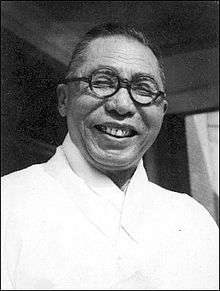
The Provisional Constitution was enacted to form the Republic of Korea as a democratic republic. It introduced the presidential system and established separate legislative, administrative and judicial branches. It succeeded the territory of the Korean Empire. Interim president Rhee was impeached and succeeded by Kim Gu. Under the Provisional Government of the Republic of Korea, he actively supported the independence movement, including the organization of the Korean Liberation Army, and received economic and military support from the Chinese Nationalists, the Soviet Union, France, the United Kingdom and the United States.
After the liberation on August 15, 1945, temporary government factors such as Kim Gu returned to Korea. On August 15, 1948, the Korean exile government and the KPG were dissolved. Rhee, who was the first president of the Provisional Government of the Republic of Korea, became the first President of the Republic of Korea in 1948. The current South Korean government through the national constitution revised in 1987 states that the South Korean people inherited the rule of the Provisional Government of the Republic of Korea[64][65][66][67][68][69], though this has been criticized by some historians as constituting revisionism.[70][71][72][73][74][75]
List of presidents
Prime minister and Presidency
- Syngman Rhee (September 11, 1919 – March 21, 1925) – Impeached by the provisional assembly[76]
- Yi Dongnyeong (June 16, 1924 – December 11, 1924) – Acting
- Park Eun-sik (December 11, 1924 – March 24, 1925) – Acting
- Park Eun-sik (March 24, 1925 – September 1925)
Presidency of the Governance and State Council Directory
- Yi Yu-pil (September 1925) – Acting
- Yi Sang-ryong (September 1925 – January 1926)
- Yang Gi-tak (January 1926 – April 29, 1926)
- Yi Dongnyeong (April 29, 1926 – May 3, 1926)
- Ahn Chang-ho (May 3, 1926 – May 16, 1926)
- Yi Dong-nyeong (May 16, 1926 – July 7, 1926)
- Hong Jin (July 7, 1926 – December 14, 1926)
- Kim Koo (December 14, 1926 – August 1927)
Chairpersonship of the State Council
- Yi Dongnyeong (August 1927 – June 24, 1933)
- Song Byeong-jo (June 24, 1933 – October 1933)
- Yi Dongnyeong (October 1933 – March 13, 1940) – Died in office
- Kim Koo (1940 – March 1947)
- Syngman Rhee (March 1947 – August 15, 1948) – Became the first President of South Korea (July 24, 1948 – April 26, 1960)
Gallery
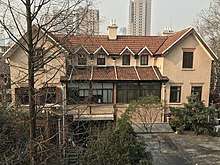 No. 50, Ruijin No. 2 Road, Huangpu District, Shanghai, the birthplace of the Provisional Government of the Republic of Korea
No. 50, Ruijin No. 2 Road, Huangpu District, Shanghai, the birthplace of the Provisional Government of the Republic of Korea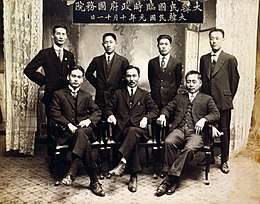 Photo memorializing the establishment of the Provisional Government, 1919
Photo memorializing the establishment of the Provisional Government, 1919 Museum of the Provisional Government in Chongqing, China
Museum of the Provisional Government in Chongqing, China- Site of the Provisional Government in Shanghai
- Taegeukgi in the Provisional Government headquarters in Shanghai
- Office of Kim Gu in the Provisional Government headquarters in Shanghai
- Declaration of war against the Axis powers by the Provisional Government
 Migration map of the Provisional Government
Migration map of the Provisional Government
See also
- History of South Korea
- Korean independence movements
- Korean Liberation Army
- Cairo Conference
- Potsdam Conference
- Memorial Day
References
- ListenOnRepeat.com. "National Anthem of Korea (1919-1948)". ListenOnRepeat.
- "임시정부 항주기념관에 김구 사진이 빠진 이유[대한민국임시정부 100년, '임정로드'를 떠나다] 일곱 번째 이야기, 항주 유적지에 가다".
- "[3ㆍ1운동.임정 百주년](38) 장제스의 임정 지원, '선의'뿐일까?".
- "[의열단100주년]⑬불꽃같은 삶 김산…비운의 '아리랑'".
- "SDC인터내셔널스쿨, 3.1운동 및 대한민국 임시정부수립 100주년 기념 나라사랑 콘서트 개최".
- "프랑스서 독립운동 홍재하 선생 후손 등 방한".
- Sources of Korean Tradition, vol. 2, From the Sixteenth to the Twentieth Centuries, edited by Yŏngho Ch'oe, Peter H. Lee, and Wm. Theodore de Bary, Introduction to Asian Civilizations (New York: Columbia University Press, 2000), 336.
- "경상남도, 대한민국임시정부 수립 100주년 기념식 열려".
- "道, 대한민국임시정부 수립 100주년 기념식".
- "청남대에 김구 주석 등 임시정부 수반 동상 세운다".
- ko:훙커우 공원 사건
- ko:조선의용대
- "광복군을 '임정 국군'에서 '대한민국 국군'으로".
- "[이희용의 글로벌시대] 기억해야 할 외국인 독립유공자 70명".
- "'한국은 독립되어야 한다' 잊혀지는 영웅, 여성 독립운동가".
- "루스벨트 대통령의 '무조건 항복론'과 '카이로선언' 재해석".
- "[1945년 오늘] 포츠담 선언 발표".
- "美원폭에 日 항복했지만… 광복 직전 '독립작전'은 이미 시작됐다".
- ko:샌프란시스코 강화 조약
- ko:여운형
- ko:근로인민당
- ko:좌우합작운동
- ko:고종 독살설
- "집앞에도 '태극기' 내걸고… 숨죽여 부르던 '애국가'도 당당하게".
- "[앵커브리핑] '한국의 의병이란 파리 떼와 같다'".
- "여주박물관, 여주 3.1운동 관련 자료 복제 완료".
- "[그날의 흔적을 찾아서] 민중의 독립의지 남한산성 봉화·횃불로 피어오르다".
- "3.1운동 시위 및 발포지역 명기한 지도 공개".
- "새롭게 밝혀진 거창 3.1 운동 기록에 '주목'".
- ko:3·1 운동
- ko:신한청년당
- "독립운동가 김규식 100년전 프랑스 고별연설 내용 최초 확인".
- "외교부, 우사(尤史) 김규식 친필 서한 원본 최초 공개".
- ko:김규식
- ko:김가진
- "임정고문 지낸 애국지사 김가진, 네번째 독립유공자 서훈심사".
- "우리 역사에서 진귀한 '노블레스 오블리주' 체현자".
- "임시정부가 상해에 있던 건 우연이 아니다".
- "임정에 돈 댄 동화약방, 상해~서울 독립 투쟁의 연결고리".
- "[역사속의 강원인물]"민족의 운명을 왜 남에게 맡기나" 끝까지 통일정부 위해 싸웠다".
- "100여년 전 조선의 엘리트들은 왜, 이곳을 찾았나".
- "[3·1운동 100주년] 역사 최전선에 우리도 있었다".
- "광복군 처음 내린 그곳에서 대한민국 100년 기념하다".
- ko:문창범
- ko:최재형
- "1919년 4월 11일, 상하이, 대한민국 임시정부 사람들".
- ko:손정도
- "독연해주 3·17 독립선언 기념식 개최".
- ko:한성 임시 정부
- ""국호는 대한민국"…임시정부, 상하이에 세운 이유는".
- ko:원세훈 (1887년)
- ko:상해 임시 정부
- "[대한민국 임시정부 100년] 하나로 뭉친 노령·상하이·한성정부…'미완의 통합임정' 세우다".
- 이승만 [Rhee Syngman]. Encyclopedia of Korean culture (in Korean). Academy of Korean Studies. Retrieved March 13, 2014.
- Eckert, Carter J., Lee, Ki-baik, Lew, Young Ick, Robinson, Michael & Wagner, Edward W. (1990). Korea old and new. Seoul: Ilchokak.
- Ministry of Patriots and Veterans Affairs (국가보훈처) (1997). 대한민국임시정부의 법통과 역사적 재조명 [Legitimacy and Historical Review of the Provisional Government of the Republic of Korea] (in Korean). Daejeon: National Archives of Korea. pp. 167–169.
- 대한민국임시정부수립기념일 [Day to celebrate the establishment of the Provisional Government of the Republic of Korea]. Encyclopedia of Korean folk culture (in Korean). National Folk Museum of Korea.
- PRC Documents, F. 1864 / 1394 / 23
- "Foreign Relations of the United States: Diplomatic Papers, 1944, The Near East, South Asia, and Africa, The Far East, Volume V - Office of the Historian". history.state.gov.
- "Foreign Relations of the United States: Diplomatic Papers, 1944, The Near East, South Asia, and Africa, The Far East, Volume V - Office of the Historian". history.state.gov.
- "美 의회 "대한민국 임시정부가 건국 시초" 결의안 발의".
- "美의회 '임시정부 100주년 한국민주주의 밑거름" 결의안".
- "美의회 "대한민국 임시정부, 韓 민주주의 성공과 번영의 토대"".
- "대통령 "미 의회도 임정을 대한민국 건국으로 인정"".
- "미 의회 "임시정부, 한국 민주주의 성공 번영의 토대"".
- "100년前 오늘, 대한민국이 탄생했다…국민주권 첫 선언".
- "美의회 "임시정부 수립이 한국 민주주의 맥동·성공·번영 토대"".
- "[팩트체크] 다시 등장한 "1948년 건국론"…확인해보니 98년 전에 작성된 1919년의 건국 통보문".
- ko:대한민국 임시 정부
- Myers, Brian Reynolds (21 February 2018). "Constitutional Reform and Inter-Korean Relations: Part 2". Sthele Press. Sthele Press. Retrieved June 25, 2019.
- Myers, Brian Reynolds (July 26, 2018). "Confederation (Again)". Sthele Press. Sthele Press. Retrieved June 25, 2019.
- Myers, Brian Reynolds (April 7, 2019). "South Korea's Nationalist-Left Front". Sthele Press. Sthele Press. Retrieved June 25, 2019.
- Myers, Brian Reynolds (4 March 2019). "On That March First Speech". Sthele Press. Sthele Press. Retrieved June 25, 2019.
- Myers, Brian Reynolds (August 11, 2017). "Low-Level Confederation and the Nuclear Crisis (in 2 parts)". Sthele Press. Sthele Press.
- Myers, Brian Reynolds (March 4, 2019). "On that March First Speech". Sthele Press. Sthele Press. Retrieved June 26, 2019x.
- ko:이승만
Further reading
External links



